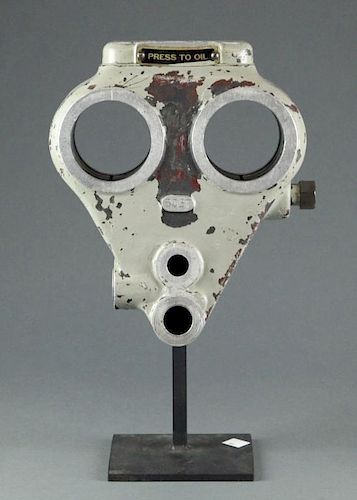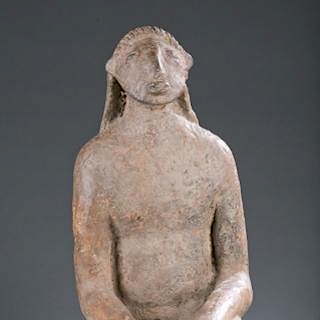Triangular shaped mask with 5036 across the front
About Seller
360 S. Washington Street
Falls Church, VA 22046
United States
Quinn's Auction Galleries is a full service auction and estate services company. We have a range of specialties, from fine art & antiques, to rare books & maps.
Two ways to bid:
- Leave a max absentee bid and the platform will bid on your behalf up to your maximum bid during the live auction.
- Bid live during the auction and your bids will be submitted real-time to the auctioneer.
Bid Increments
| Price | Bid Increment |
|---|---|
| $0 | $10 |
| $300 | $25 |
| $500 | $50 |
| $1,000 | $100 |
| $3,000 | $250 |
| $5,000 | $500 |
| $15,000 | $1,000 |
| $20,000 | $2,000 |
| $30,000 | $2,500 |
| $100,000 | $5,000 |
About Auction
Oct 1, 2016 - Oct 2, 2016
Quinn's Auction Galleries dquinn@quinnsauction.com
- Lot Description
A triangular shaped found art piece in the form of a mask, was part of an engine block. USA. 20th century. 10 1/2"h x 9"w x 3 3/4"d.
Condition: Excellent
Provenance: Private Midwest CollectorCatalog Notes: "The amassment and display of found objects for their aesthetic qualities dates back to at least the 16th century, when the collections of individual enthusiasts were displayed in private "cabinets of curiosities," or what the Germans called "Wunderkammer." But it wasn't until the 1900s that artists began to incorporate found objects into sculptural works as an artistic gesture. The term "found object" is a literal translation from the French objet trouv�, meaning objects or products with non-art functions that are placed into an art context and made part of an artwork; what we now call "the readymade" is an updated version of that idea. Marcel Duchamp is usually credited as inventing the readymade, but the essential idea of taking something preexisting and elevating it into art did exist before he created his first one (a bicycle wheel atop a kitchen stool) in 1913: in Pablo Picasso's Still Life With Chair Caning from 1912, for example, the artist collaged a piece of woven chair backing onto a two-dimensional canvas, and before that Degas clothed his Little Dancer of Fourteen Years (1881) in a real tutu. Much of early modern art was concerned with representation and how to reconcile art's illusionism with its real object status (think of Ren� Magritte's Ceci n'est pas une pipe from 1929). As part of that greater conversation, the objet trouv� was understood to be a raw material used in an assemblage in a way that called attention to its real material qualities and inherent aesthetic. Taking this idea one step further, Duchamp's readymades invented a new category of artworks composed entirely out of manufactured, pre-made objects that stood on their own as autonomous works of art. THE READYMADE Marcel Duchamp's Fountain, 1917 Duchamp's Fountain of 1917 is the artist'sラand perhaps the world'sラmost famous readymade sculpture. Duchamp submitted the work, simply consisting of a porcelain urinal that's been placed on its back on a pedestal and signed "R. Mutt" by the artist, for an show at the Society of Independent Artists in 1917. It was rejected by the exhibition committee, but is now considered a foundational work for much of the artistic experimentation over the past century. Other items that the artist transformed into "pure ready-mades," as he called them, included a bottle rack (Bottle Rack, 1914) and a snow shovel (In Advance of the Broken Arm, 1915). Duchamp's appropriations of everyday objects had far-reaching implications, and continue to shape the conversation around art today as a primarily intellectual, rather than strictly material, pursuit, a product of the artist's mind rather than one of manual skill honed to technical perfection. (モI was interested in ideasラnot merely in visual products,ヤ said Duchamp.) Almost immediately, artists associated with European Dada took up the torch from 1916 through the 1920s, resulting in works like Man Ray's The Gift (1921), a flatiron with brass tacks attached to its underside, rendering it bizarrely useless. Later, in the '50s, the artist Arman embedded money, garbage, and entire cars inside his sculptural works." Ian Wallace, Art Space, "The History of the Found Object in Art", April 20, 2014. - Shipping Info
-
Shipping and Handling Policy:
Quinn's Auctions ONLY ships with FedEx Domestic and USPS internationally. We do not ship Media Mail. Shipping costs are based on the weight of your lots and your location. We require a complete shipping address and phone number to process your shipping quote. You will receive your shipping quote in your invoice via your registered email with a tracking number if available. Once payment is received Quinns will ship items FedEx ground in the United States, USPS International or release items to an outside shipper.Quinn's Auctions reserves the right to recommend an outside shipper based on fragility and size of lot. We offer recommendations for outside shipping by trusted shippers if necessary. If using an outside shipper Quinn's Auctions is not responsible for damages by carriers or packers of purchased lots, whether or not recommended by Quinn's Auctions and will not be liable for any losses which result.
-
- Buyer's Premium



 EUR
EUR CAD
CAD AUD
AUD GBP
GBP MXN
MXN HKD
HKD CNY
CNY MYR
MYR SEK
SEK SGD
SGD CHF
CHF THB
THB














